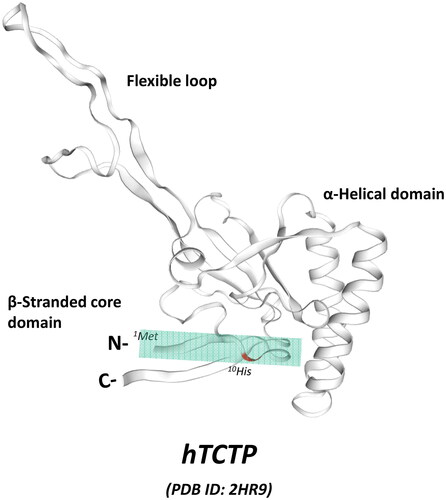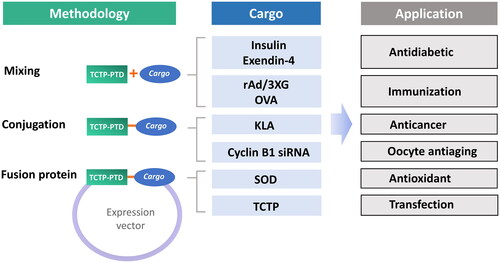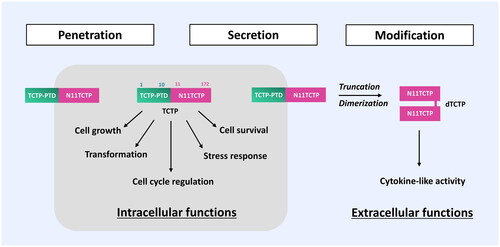Figures & data
Figure 1. The N-terminal location of TCTP-PTD in the solution structure of human TCTP (hTCTP). NMR structure of hTCTP (Feng et al., Citation2007) was obtained from the ExPasy website (PDB ID: 2HR9, https://swissmodel.expasy.org), SWISS-MODEL repository (Bienert et al., Citation2017). The major domains of hTCTP is indicated such as flexible loop, α-helical domain, and β-stranded core domain. TCTP-PTD (1-MIIYRDLISH-10) is located at N-terminus of TCTP, as highlighted with colored box.

Figure 2. Studies using the TCTP-PTD with various cargos. TCTP-PTD or its variants were complexed with various cargos by simple mixing (for insulin, exendin-4, ovalbumin, and rAd/3XG), covalent conjugation (for KLA and cyclin B1 siRNA), or fusion protein (SOD and TCTP). TCTP-PTD and their effectiveness in the delivery of therapeutics for diabetes, cancer and brain damage, and of antigens for immunization were studied.

Table 1. Examples of use of TCTP-PTD and its variants in the delivery of various cargos.
Figure 3. Role of TCTP-PTD in the regulation of intracellular and extracellular actions. TCTP itself can translocate into cells and retains its intracellular activity. Following secretion of TCTP from cells via a non-classical pathway (Amzallag et al., Citation2004), TCTP is subjected to proteolytic cleavage, resulting in the truncated product TCTP-PTD (1-10), liberating N11TCTP (11-172). N11TCTP is then dimerized under the specific pathologic conditions to form the histamine-releasing factor (HRF), the critical moiety responsible for the extracellular functions of TCTP (Kim et al., Citation2013). TCTP-PTD-truncated forms, such as N11-TCTP and dTCTP (HRF) cannot cross the plasma membrane, indicating the TCTP-PTD’s role in the plethora of TCTP functions in and out of the cell.

Table 2. Comparison of TCTP-PTD with TAT-PTD.
